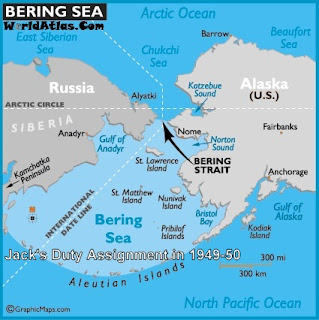From here, he went on to his first major duty assignment that lasted almost two years - the 103rd NCB (Naval Construction Battalion) in Guam in the South Pacific. He lived in a tent for over a year then upgraded to a Quonset hut shown below.
| YEAR | LOCATION | ASSIGNMENT |
| August 1946 | Bainbridge, MD | Basic Training |
| Oct 1946 | Port Hueneme, CA | Radio and Communication School |
| Jan 1947 | Guam, Mariana Islands 103rd NCB | Duty Assignment 1 |
| Apr 1949 | Adak, Aleutian Islands | Duty Assignment 2 |
| July 1950 | Seattle, WA | Discharge |
Jack's second major duty assignment while serving in the Navy was in the Aleutian Islands at the southern Bering Sea. He was assigned to Adak Island which sits on Kuluk Bay, 1,300 miles southwest of Anchorage on the latitude of Vancouver Island in Canada. It has a population of 320 (source of stats: navy history). Jack may hold the distinction in the Siulinski family to have traveled to the area where man first walked onto the American continent via the Bering Land Bridge. Ages ago, much of the Earth's water supply was locked up in huge ice masses. Eventually, the sea level fell exposing vast areas of land (previously underwater) creating a continuous land bridge that stretched between Siberia and Alaska. Most archaeologists agree that it was across this Bering Land Bridge, also called Beringia, that humans first passed from Asia to populate the Americas.
Source for the map: worldatlas
Source for the text describing the Bering Land Bridge: PBS
One of the most vivid images that Jack offered during numerous hours of being interviewed for his life story was when he flew over the Aleutian Islands.
Source for the text describing the Bering Land Bridge: PBS
One of the most vivid images that Jack offered during numerous hours of being interviewed for his life story was when he flew over the Aleutian Islands.
"We flew practically to the end of the Aleutian chain. We were flying a route above the mountaintops, you could see the craters of active mountains [volcanoes]."
 |
| Mt Edgecumbe outside of Sitka
Image source: AlaskaPride Blog
While serving in Alaska, possibly brought on by the elements and stress of work, Jack suffered a collapsed lung in June of 1950. While hospitalized in Alaska for diagnosis and observation, the Korean War flared up. He was sent to Seattle on a ship where he was then discharged on July 26, 1950j, and sent back to Maine on a train. Ironically and fortunately, the illness may have prevented a tour of duty in Korea. Unfortunately, though, the July discharge in Seattle was processed just one month prior to Jack completing his full tour of duty. HE would later have problems re-enlisting into the Navy Reserves which he tried to do before meeting his future wife. This issue may have also affected Jack not receiving a full disability upon discharge which would have provided living benefits for him and his family during the time of convalescence. Although his condition was later deemed to be "service-connected", he was only entitled to the medical benefits necessary to treat the condition. These facts made life difficult for a while but he persevered through the time of marriage and a new family. (source: Oct 1952 VA letter from personal archives of Jack Siulinski)
Although Jack did not face combat in his service years, he did serve in the Navy during the time that the World War II Victory Medal was awarded to servicemen.
Endnote: Much of the material for this post was taken from a recorded interview with Jack in 2007. Also, many documents and pictures saved from his military days were used to create the story of his military life beginning in 1946 to the time period after his discharge and when he met his wife in 1950.
|


.jpg)



3 comments:
Great post Uncle Craig, very interesting!
Welcome to the Geneabloggers family. Hope you find the association fruitful; I sure do. I have found it most stimulating, especially some of the Daily Themes.
May you keep sharing your ancestor stories!
Dr. Bill ;-)
http://drbilltellsancestorstories.blogspot.com/
Author of "Back to the Homeplace"
and "13 Ways to Tell Your Ancestor Stories"
http://www.examiner.com/x-53135-Springfield-Genealogy-Examiner
http://www.examiner.com/x-58285-Ozarks-Cultural-Heritage-Examiner
Saw you here today, so I came to check it out. I book marked you, since you have no follow.
Great stuff, keep it going.
Post a Comment